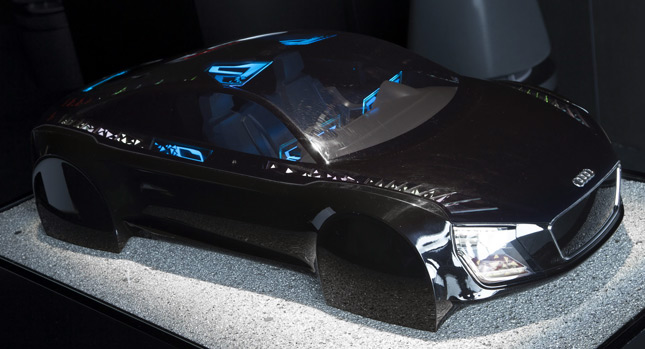The brand with the four rings from Ingolstadt has always strived to be more than just another luxury carmaker placing a heavy emphasis on technology.
That said, it’s only natural that Audi would participate in the 2013 Consumer Electronics Show (CES), which is held in Las Vegas from January 8 to 11, and is considered as the world’s most important electronics trade show.
Audi welcomed show-goers with a host of current technologies and future solutions ranging from its autonomous driving and networking systems to the latest developments in lighting and customizable digital instrument panels.
 Of particular interest are Audi’s experimental lighting solutions, including the laser tail light generated by a laser diode, said to provide drivers behind with a bright, clear signal, which changes shape according to the weather and lighting conditions.
Of particular interest are Audi’s experimental lighting solutions, including the laser tail light generated by a laser diode, said to provide drivers behind with a bright, clear signal, which changes shape according to the weather and lighting conditions.
Anyone following the latest developments in electronics will no doubt have heard about OLED televisions such as LG’s first production sets that have the potential to provide better image quality (including deeper blacks) than plasma TV’s, albeit at a much, much higher cost for now.
Well, Audi is proposing the same lighting tech for its next generation models. Unlike the LEDs currently in use and which consist of semiconductor crystals, an OLED (organic light-emitting diode) is made from an organic material that is spread extremely thinly (only a few thousandths of a millimeter thick) on an absolutely flat surface like a highly polished display glass. Once an electric voltage is applied, the molecules emit photons and the surface lights up.
Audi says the light distribution is very homogeneous and extremely energy-efficient. The automaker said it plans to adopt OLEDs for use in the interior and the tail lamps of its vehicles in the not so distant future.
The carmaker also displayed a demonstrator concept fitted with an array of OLEDs spread on the rear end forming a continuous light surface with innumerable small points of flickering lights.
“The movements of the red dots follow the movements of the vehicle,” explained Audi. “When a right turn is made, they flow to the right; when the car is braked, they flow rapidly forwards; the faster the car goes, the faster they move. The following driver can always see right away what the driver of the car in front is doing.”
The German carmaker has also adopted another variant of OLED technology named AMOLED (active matrix organic light emitting diode) for use in digital rearview mirrors found on its competition R18 e-tron quattro racer as well as the R8 e-tron.
The 6.8-inch AMOLED screen with 600,000-plus pixels and a depth of just 7mm (0.28-inches) is claimed to offer ten times more contrast while consuming around 30 percent less energy than a corresponding LCD monitor.
On the networking front, Audi said it plans new developments that will connect its cars with the environment as well as other vehicles.
“At Audi you’d be hard pushed to find an innovation that isn’t related to electronics nowadays,” explains Ricky Hudi, Head of Electrics/Electronics Development. “These enable us to implement full networking. A defining feature of the last decade was that we integrated all the functions in the car. This decade will see us network the car seamlessly with the environment, under the Audi connect banner – with the driver, the Internet, the infrastructure, and with other vehicles.”
PHOTO GALLERY









































